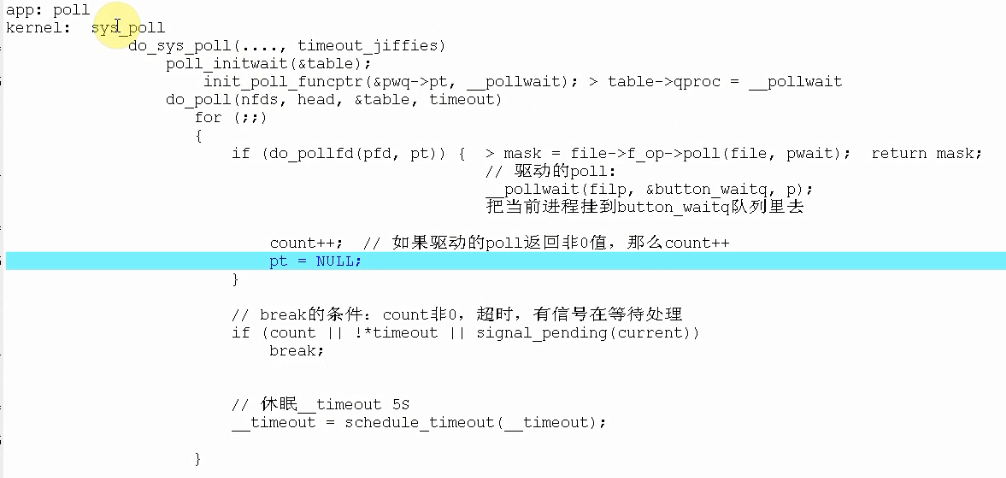前面的按键中断驱动,只能实现当有按键按下的时候,输出,平时cpu处于休眠状态。如果我想实现,休眠一段时间执行一些指令,当有中断发生时,cpu又可以立即响应。那就得用poll机制。
poll机制分析
韦东山 2009.12.10
所有的系统调用,基于都可以在它的名字前加上“sys_”前缀,这就是它在内核中对应的函数。比如系统调用open、read、write、poll,与之对应的内核函数为:sys_open、sys_read、sys_write、sys_poll。
一、内核框架:
对于系统调用poll或select,它们对应的内核函数都是sys_poll。分析sys_poll,即可理解poll机制。
1. sys_poll函数位于fs/select.c文件中,代码如下:
asmlinkage long sys_poll(struct pollfd __user *ufds, unsigned int nfds,
long timeout_msecs)
{
s64 timeout_jiffies;
if (timeout_msecs > 0) {
#if HZ > 1000
/* We can only overflow if HZ > 1000 */
if (timeout_msecs / 1000 > (s64)0x7fffffffffffffffULL / (s64)HZ)
timeout_jiffies = -1;
else
#endif
timeout_jiffies = msecs_to_jiffies(timeout_msecs);
} else {
/* Infinite (< 0) or no (0) timeout */
timeout_jiffies = timeout_msecs;
}
return do_sys_poll(ufds, nfds, &timeout_jiffies);
}
它对超时参数稍作处理后,直接调用do_sys_poll。
2. do_sys_poll函数也位于位于fs/select.c文件中,我们忽略其他代码:
int do_sys_poll(struct pollfd __user *ufds, unsigned int nfds, s64 *timeout)
{
……
poll_initwait(&table);
……
fdcount = do_poll(nfds, head, &table, timeout);
……
}
poll_initwait函数非常简单,它初始化一个poll_wqueues变量table:
poll_initwait > init_poll_funcptr(&pwq->pt, __pollwait); > pt->qproc = qproc;
即table->pt->qproc = __pollwait,__pollwait将在驱动的poll函数里用到。
3. do_poll函数位于fs/select.c文件中,代码如下:
static int do_poll(unsigned int nfds, struct poll_list *list,
struct poll_wqueues *wait, s64 *timeout)
{
01 ……
02 for (;;) {
03 ……
04 if (do_pollfd(pfd, pt)) {
05 count++;
06 pt = NULL;
07 }
08 ……
09 if (count || !*timeout || signal_pending(current))
10 break;
11 count = wait->error;
12 if (count)
13 break;
14
15 if (*timeout < 0) {
16 /* Wait indefinitely */
17 __timeout = MAX_SCHEDULE_TIMEOUT;
18 } else if (unlikely(*timeout >= (s64)MAX_SCHEDULE_TIMEOUT-1)) {
19 /*
20 * Wait for longer than MAX_SCHEDULE_TIMEOUT. Do it in
21 * a loop
22 */
23 __timeout = MAX_SCHEDULE_TIMEOUT - 1;
24 *timeout -= __timeout;
25 } else {
26 __timeout = *timeout;
27 *timeout = 0;
28 }
29
30 __timeout = schedule_timeout(__timeout);
31 if (*timeout >= 0)
32 *timeout += __timeout;
33 }
34 __set_current_state(TASK_RUNNING);
35 return count;
36 }
分析其中的代码,可以发现,它的作用如下:
① 从02行可以知道,这是个循环,它退出的条件为:
a. 09行的3个条件之一(count非0,超时、有信号等待处理)
count非0表示04行的do_pollfd至少有一个成功。
b. 11、12行:发生错误
② 重点在do_pollfd函数,后面再分析
③ 第30行,让本进程休眠一段时间,注意:应用程序执行poll调用后,如果①②的条件不满足,进程就会进入休眠。那么,谁唤醒呢?除了休眠到指定时间被系统唤醒外,还可以被驱动程序唤醒──记住这点,这就是为什么驱动的poll里要调用poll_wait的原因,后面分析。
4. do_pollfd函数位于fs/select.c文件中,代码如下:
static inline unsigned int do_pollfd(struct pollfd *pollfd, poll_table *pwait)
{
……
if (file->f_op && file->f_op->poll)
mask = file->f_op->poll(file, pwait);
……
}
可见,它就是调用我们的驱动程序里注册的poll函数。
二、驱动程序:
驱动程序里与poll相关的地方有两处:一是构造file_operation结构时,要定义自己的poll函数。二是通过poll_wait来调用上面说到的__pollwait函数,pollwait的代码如下:
static inline void poll_wait(struct file * filp, wait_queue_head_t * wait_address, poll_table *p)
{
if (p && wait_address)
p->qproc(filp, wait_address, p);
}
p->qproc就是__pollwait函数,从它的代码可知,它只是把当前进程挂入我们驱动程序里定义的一个队列里而已。它的代码如下:
static void __pollwait(struct file *filp, wait_queue_head_t *wait_address,
poll_table *p)
{
struct poll_table_entry *entry = poll_get_entry(p);
if (!entry)
return;
get_file(filp);
entry->filp = filp;
entry->wait_address = wait_address;
init_waitqueue_entry(&entry->wait, current);
add_wait_queue(wait_address, &entry->wait);
}
执行到驱动程序的poll_wait函数时,进程并没有休眠,我们的驱动程序里实现的poll函数是不会引起休眠的。让进程进入休眠,是前面分析的do_sys_poll函数的30行“__timeout = schedule_timeout(__timeout)”。
poll_wait只是把本进程挂入某个队列,应用程序调用poll > sys_poll >do_sys_poll > poll_initwait,do_poll > do_pollfd > 我们自己写的poll函数后,再调用schedule_timeout进入休眠。如果我们的驱动程序发现情况就绪,可以把这个队列上挂着的进程唤醒。可见,poll_wait的作用,只是为了让驱动程序能找到要唤醒的进程。即使不用poll_wait,我们的程序也有机会被唤醒:chedule_timeout(__timeout),只是要休眠__time_out这段时间。
现在来总结一下poll机制:
1. poll > sys_poll > do_sys_poll > poll_initwait,poll_initwait函数注册一下回调函数__pollwait,它就是我们的驱动程序执行poll_wait时,真正被调用的函数。
2. 接下来执行file->f_op->poll,即我们驱动程序里自己实现的poll函数
它会调用poll_wait把自己挂入某个队列,这个队列也是我们的驱动自己定义的;
它还判断一下设备是否就绪。
3. 如果设备未就绪,do_sys_poll里会让进程休眠一定时间
4. 进程被唤醒的条件有2:一是上面说的“一定时间”到了,二是被驱动程序唤醒。驱动程序发现条件就绪时,就把“某个队列”上挂着的进程唤醒,这个队列,就是前面通过poll_wait把本进程挂过去的队列。
5. 如果驱动程序没有去唤醒进程,那么chedule_timeout(__timeou)超时后,会重复2、3动作,直到应用程序的poll调用传入的时间到达。
驱动程序如下:
#include <linux/module.h>
#include <linux/kernel.h>
#include <linux/fs.h>
#include <linux/init.h>
#include <linux/delay.h>
#include <linux/irq.h>
#include <asm/uaccess.h>
#include <asm/irq.h>
#include <asm/io.h>
#include <asm/arch/regs-gpio.h>
#include <asm/hardware.h>
#include <linux/poll.h>
static struct class *forthdrv_class;
static struct class_device *forthdrv_class_dev;
volatile unsigned long *gpfcon;
volatile unsigned long *gpfdat;
volatile unsigned long *gpgcon;
volatile unsigned long *gpgdat;
static DECLARE_WAIT_QUEUE_HEAD(button_waitq);
/* 中断事件标志, 中断服务程序将它置1,forth_drv_read将它清0 */
static volatile int ev_press = 0;
struct pin_desc{
unsigned int pin;
unsigned int key_val;
};
/* 键值: 按下时, 0x01, 0x02, 0x03, 0x04 */
/* 键值: 松开时, 0x81, 0x82, 0x83, 0x84 */
static unsigned char key_val;
struct pin_desc pins_desc[4] = {
{S3C2410_GPF0, 0x01},
{S3C2410_GPF2, 0x02},
{S3C2410_GPG3, 0x03},
{S3C2410_GPG11, 0x04},
};
/*
* 确定按键值
*/
static irqreturn_t buttons_irq(int irq, void *dev_id)
{
struct pin_desc * pindesc = (struct pin_desc *)dev_id;
unsigned int pinval;
pinval = s3c2410_gpio_getpin(pindesc->pin);
if (pinval)
{
/* 松开 */
key_val = 0x80 | pindesc->key_val;
}
else
{
/* 按下 */
key_val = pindesc->key_val;
}
ev_press = 1; /* 表示中断发生了 */
wake_up_interruptible(&button_waitq); /* 唤醒休眠的进程 */
return IRQ_RETVAL(IRQ_HANDLED);
}
static int forth_drv_open(struct inode *inode, struct file *file)
{
/* 配置GPF0,2为输入引脚 */
/* 配置GPG3,11为输入引脚 */
request_irq(IRQ_EINT0, buttons_irq, IRQT_BOTHEDGE, "S2", &pins_desc[0]);
request_irq(IRQ_EINT2, buttons_irq, IRQT_BOTHEDGE, "S3", &pins_desc[1]);
request_irq(IRQ_EINT11, buttons_irq, IRQT_BOTHEDGE, "S4", &pins_desc[2]);
request_irq(IRQ_EINT19, buttons_irq, IRQT_BOTHEDGE, "S5", &pins_desc[3]);
return 0;
}
ssize_t forth_drv_read(struct file *file, char __user *buf, size_t size, loff_t *ppos)
{
if (size != 1)
return -EINVAL;
/* 如果没有按键动作, 休眠 */
wait_event_interruptible(button_waitq, ev_press);
/* 如果有按键动作, 返回键值 */
copy_to_user(buf, &key_val, 1);
ev_press = 0;
return 1;
}
int forth_drv_close(struct inode *inode, struct file *file)
{
free_irq(IRQ_EINT0, &pins_desc[0]);
free_irq(IRQ_EINT2, &pins_desc[1]);
free_irq(IRQ_EINT11, &pins_desc[2]);
free_irq(IRQ_EINT19, &pins_desc[3]);
return 0;
}
static unsigned forth_drv_poll(struct file *file, poll_table *wait)
{
unsigned int mask = 0;
poll_wait(file, &button_waitq, wait); // 不会立即休眠 把当前进程挂到button_waitq队列中去
if (ev_press)
mask |= POLLIN | POLLRDNORM;
return mask;
}
static struct file_operations sencod_drv_fops = {
.owner = THIS_MODULE, /* 这是一个宏,推向编译模块时自动创建的__this_module变量 */
.open = forth_drv_open,
.read = forth_drv_read,
.release = forth_drv_close,
.poll = forth_drv_poll,
};
int major;
static int forth_drv_init(void)
{
major = register_chrdev(0, "forth_drv", &sencod_drv_fops);
forthdrv_class = class_create(THIS_MODULE, "forth_drv");
forthdrv_class_dev = class_device_create(forthdrv_class, NULL, MKDEV(major, 0), NULL, "buttons"); /* /dev/buttons */
gpfcon = (volatile unsigned long *)ioremap(0x56000050, 16);
gpfdat = gpfcon + 1;
gpgcon = (volatile unsigned long *)ioremap(0x56000060, 16);
gpgdat = gpgcon + 1;
return 0;
}
static void forth_drv_exit(void)
{
unregister_chrdev(major, "forth_drv");
class_device_unregister(forthdrv_class_dev);
class_destroy(forthdrv_class);
iounmap(gpfcon);
iounmap(gpgcon);
return 0;
}
module_init(forth_drv_init);
module_exit(forth_drv_exit);
MODULE_LICENSE("GPL");
测试程序如下:
#include <sys/types.h>
#include <sys/stat.h>
#include <fcntl.h>
#include <stdio.h>
#include <poll.h>
/* forthdrvtest
*/
int main(int argc, char **argv)
{
int fd;
unsigned char key_val;
int ret;
struct pollfd fds[1];
fd = open("/dev/buttons", O_RDWR);
if (fd < 0)
{
printf("can't open!\n");
}
fds[0].fd = fd;
fds[0].events = POLLIN;
while (1)
{
ret = poll(fds, 1, 5000);
if (ret == 0)
{
printf("time out\n");
}
else
{
read(fd, &key_val, 1);
printf("key_val = 0x%x\n", key_val);
}
}
return 0;
}
关于poll的用法可以在服务器端输入:man poll
























 1546
1546

 被折叠的 条评论
为什么被折叠?
被折叠的 条评论
为什么被折叠?










